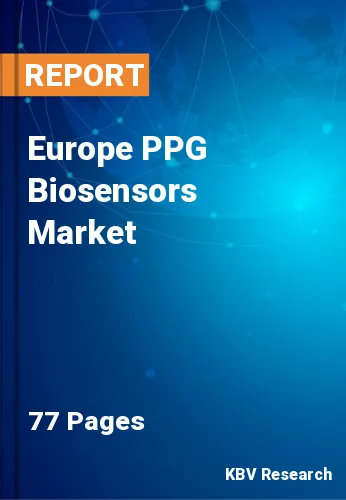The Europe PPG Biosensors Market would witness market growth of 11.9% CAGR during the forecast period (2021-2027).
PPG signal’s second derivative wave includes crucial health-related data that are really helpful for better measurements. Therefore, evaluating this waveform is extremely beneficial for researchers and clinicians to examine diverse cardiovascular-related diseases like atherosclerosis and arterial stiffness. In addition, the evaluation of the second derivative wave of the PPG signal would also help in detecting and diagnosing many cardiovascular diseases at an early stage, which can possibly appear later in life. It is very important to do consistent and real-time monitoring of these diseases for early recognition and analysis, which is only possible by the advent of new technological developments in sensor technology & wireless communications. There are many developments & challenges going on in the market of PPG biosensors that are widely used in various wearables devices to keep track of heart rates and others.
Radius PPG abolishes the requirement for attached cable to a pulse oximetry monitor, which helps patients to travel freely and securely and also constantly and accurately monitored by such devices. In addition, the growing prevalence of cardiovascular diseases and a growing geriatric population, and the rising demand for wearable monitoring gadgets, are bolstering the growth of the segment.
There is a growing awareness among the population regarding maintaining and monitoring their health regularly to protect themselves from any kind of disease. Due to this, people are majorly adopting smart healthcare systems or devices to perform this task. In addition, the population of various chronic diseases like heart-related diseases is also increasing, which propels the growth of the PPG biosensors as they are used in several medical devices to measure heart rate, oxygen level, etc.
The increasing popularity of smart & portable healthcare devices is driving regional growth. In addition, the growing cases of hypertension and heart-related diseases in various nations of this region will also contribute to the increasing demand for PPG biosensors in the region. The population across this region is more aware of maintaining a healthy lifestyle along with getting a regular checkup, for which they are highly adopting wearables that can monitor their health.
All such factors are collaboratively working to boost the demand for PPG biosensors in the regional market. Thus, this region is estimated to open new growth avenues for the manufacturers to prosper in the regional PPG biosensors market during the forecast period.
The Germany market dominated the Europe Blood-oxygen Saturation Market by Country in 2020, thereby, achieving a market value of $9,792.3 Thousands by 2027. The UK market is exhibiting a CAGR of 11% during (2021-2027). Additionally, The France market is anticipated to witness a CAGR of 13.5% during (2021-2027).
Based on Product, the market is segmented into Smart Watches, Pulse Oximeters, Smart Wrist Bands and Other Products. Based on Application, the market is segmented into Heart Rate Monitoring, Blood Pressure, Blood-oxygen Saturation and Other Applications. Based on countries, the market is segmented into Germany, UK, France, Russia, Spain, Italy, and Rest of Europe.
Free Valuable Insights: The Global PPG Biosensors Market Size will Hit $759.3 Million by 2027, at a CAGR of 12.2%
The market research report covers the analysis of key stake holders of the market. Key companies profiled in the report include Texas Instruments, Inc., Vishay Intertechnology, Inc.., Renesas Electronics Corporation, AMS AG, Murata Manufacturing Co., Ltd., MediaTek, Inc., Maxim Integrated Products, Inc., Silicon Laboratories, Inc., Valencell, Inc., and LifeQ.
By Product
By Application
By Country
Our team of dedicated experts can provide you with attractive expansion opportunities for your business.

